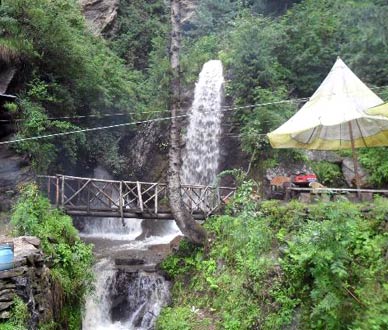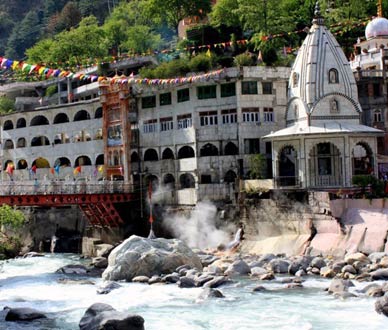Manali Tourism
Situated at a height of 6260 feet above sea level, Manali is one of the most popular, beautiful and awe-inspiring hill stations in this country. A valley located in the Kullu district of Himachal Pradesh, Manali overwhelms its visitors by flowering apple trees and adventurous snow covered roads.
Surrounded by majestic hills and woody forests, the quaint charm of Manali has captured the world’s attention and has become one of the most visited tourist destinations in India. The pristine River Beas flows right through the town, creating a mesmerising and spellbinding landscape. Nestled at one end of the Kullu Valley, Manali is a popular hill station with attractions such as the Rohtang Pass and Solang Valley nearby. Rohtang Pass is covered with snow throughout the year and is a good experience in itself. This is the ideal place for tourists looking to unwind and rejuvenate in the lap of nature, for there is no place in the country more vibrant and charming as Manali.
The valley of gods, as the Kullu valley has come to be known, is perhaps the most delightful region in the western Himalayas. The ancient Hindus regarded it as the furthest limit of human habitation – Kulantapitha, and its original name finds mention in the epics, the Ramayana and the Mahabharata as well as Vishnu Purana.
This town also has a multitude of options for tourists looking for adventurous activities like trekking, paragliding, skiing, zorbing, white water rafting etc. Besides adventurous activities, Manali also has a lot of temples which all tourists and devotees love to visit including the Raghunath temple and Jagannathi Devith Temple being one of the important ones. Hadimba Temple, a 14th-century temple is famous for its wooden architecture and for its religious values. Manali is also used as the base town for the Manali-Leh highway and Leh is around 479 km from here. Lahaul and Spiti district can also be accessed from here during the summers using the same highway.
Places to see in Manali
Kothi
12 km. A quiet but picturesque spot. The Rest House overlooks the narrow valley and commands views of the mountains. Below Kothi, for more than a kilometre the river Beas flows through a deep gorge, almost a subterranean passage, 30 metres or more in depth, and the cliffs which flank both sides of the canyon are a favourite haunt for rock pigeons. The site of the bridge provides an interesting historical episode in the early annals of Kullu.
Solang Valley
13 km. A splendid valley between Manali and Kothi which offers views of the glaciers and snow-capped mountain peaks. The plateau is frequently used for holding camps by the trekking parties. Good skiing slopes of the Mountaineering Institute. Venue of annual winter carnival from February 10-14. Bus service upto Palchan village (10 km) and then by jeep or on foot.
Rahla Falls
2 km from Kothi. Here the river Beas hurtles down from a height of about 50 metres. Charming spot for picnics.
Manali Sanctuary
A bridle path from the Manali log huts goes past the Dhoongri Temple and wanders into the dense deodar, kail, horse chestnut, walnut and maple forest which is a part of this sanctuary. Camping overnight in tents at Lambadug or Galiani Thatch is possible.
Lush green alpine pastures and glaciers lie beyond Galiani Thatch. Musk deer, monal and brown bear are often spotted. For those who venture still further into the glacier zone in summer, there are herds of ibex.
Rohtang Pass
51 km. At an altitude of 4,112 metres on the highway to Keylong, the pass affords a wide-spread panorama of mountain scenery. In place of the pinnacled hills, sheltered valleys and cultivated tracts, the eye meets a range of precipitous cliffs, huge glaciers and piled Moraine, and deep ravines. Almost directly opposite is the well defined Sonepani glacier, slightly to the left are the twin peaks of the Geypang, jagged pyramids of rock, snow streaked and snow crowned.
The Beas river rises near the crest of Rohtang from a block of Mica-Schist. The pass normally opens for traffic after mid-June and officially closes in November. To its left, 200 metres higher, is the little lake of Sarkund (Dashair) visited by a number of people, the general belief being that a bath in these waters effects a cure of all bodily ailments-real or imaginary. 10 km before Rohtang is the barren-landscape of Marhi which hums with activity during summer and autumn months because almost everyone stops here for refreshments.
Triloknath and Udeypur
These are two important places of pilgrimage in Pattan Valley. At Triloknath is a six armed image in white marble of Avalokiteshvara, Bodhisattava. Visitors will enjoy crossing the Chandra-Bhaga river and the trek of 3 km to reach the destination. The temple of Marikula at Udeypur is highly remarkable for its wood carvings. Udeypur is 166 km from Manali.
Raghunathji Temple
1 km. In the 17th century, Raja Jagat Singh installed here an idol of Lord Raghunathji, which he brought from Ayodhya. As a mark of his penance he placed the idol on his throne and it became the presidind deity of the valley.
Bijli Mahadev Temple
11 km. The Bijli Mahadev temple one of the most striking temple is set on a spur, and is famous for its 60 ft high staff which periodically attracts lightning that shatters the Shivalinga. Each time this happens, it is pieced together by the temple priest.
The Great Himalayan National Park
Located in the beautiful district of Kullu, the 620 sq. km. area has temperate forests – some of the virgin coniferous forests of the state. Vast areas of alpine pasture and glaciers cap this park. Among the animals found in this part of the western Himalayas are musk deer, ghoral, thar, bharal, sewor, brown bear, leopard and snow leopard. Bird life includes a variety of colourful pheasants – monal, khalij, cheer and tragopan. A trek through the park to Rekte-Sar, the origin of the Sainj River and camping amid alpine pastures is a memorable experience.
Bajeshwar Mahadev Temple (Bajaura)
15 km. The pyramidical temple (9th century AD) is embellished with wonderful carvings in stone and sculptural decorations. The three large image slabs on the exterior are all of a high order of sculpture in the Indian classical (Shikara) style.
Kasol
42 km. Situated on the banks of Parvati river, Kasol in the Parvati valley makes a good holiday destination. Charmingly located in an open space which slopes down to a broad expanse of clear white sand at the edge of the river. The place is known for trout fishing.
Manikaran
45 km. On the trekking route to Pulga and Pin Parvati pass, Manikaran is famous for its hot springs. Thousands of people take a dip in its hot waters. The water is so hot that dal (pulses), rice etc. can be boiled in it. It is also a well known pilgrimage centre and there is an ancient Hindu temple and a gurdwara here. According to a legend, Manikaran is also associated with Lord Shiva and his divine consort, Parvati, who lost and recovered her ear-ring here.
Pulga and Khirganga
16 km. A stiff march takes one to the restful solitude of the Forest Rest House whose immediate environment affords a sylvan and peaceful retreat for body and mind. The Tos nullah, which branches off from the main Paravati valley is well worth exploration by those who favour the wilder aspects of natural scenery and are prepared to camp out. 10 km from Pulga lies Khirganga which is well-known for its hot springs.
Naggar
28 km. On the left bank of the Beas and about three hundred metres above the river, Naggar is delightfully situated on a wooded slope and commands an extensive view, especially of the north west of the valley. It is an excellent place for a longer stay. Naggar was the capital of the Kullu Rajas for about 1,400 years. There are a large number of famous temples in and around Naggar. Artist Nicholas Roerich’s art gallery is also worth a visit. Cars and jeeps can easily go up to the Naggar Castle which is now Himachal Tourism’s well furnished Hotel Castle.


